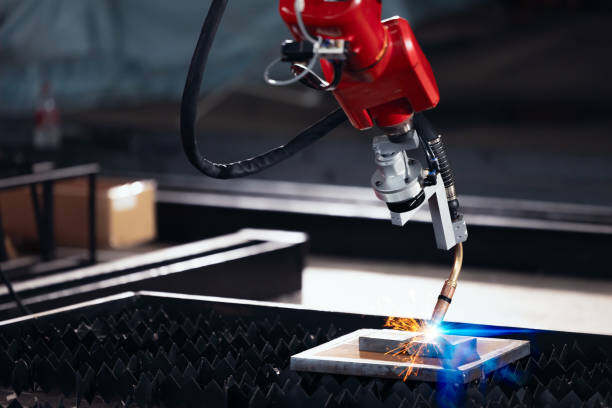In today’s competitive manufacturing landscape, every second and every micron counts. Fabricators across automotive, aerospace, electronics, and heavy industry are pushing for faster production, tighter tolerances, and cleaner welds. Traditional arc welding methods—though reliable—are increasingly challenged by demands for automation, minimal distortion, and precision in complex assemblies.
This is where laser welding—also known as laser beam welding (LBW) — has revolutionized the fabrication process. By focusing an intense beam of light onto metal surfaces, it delivers deep, narrow, and ultra-clean welds with minimal heat input. Beyond technical advantages, laser welding transforms how products are designed, built, and finished, empowering manufacturers to achieve higher quality at lower overall cost.

I. What Is Laser Welding?
Laser welding is a process that uses a highly concentrated laser beam to melt and fuse metal parts together. Unlike MIG or TIG welding, it’s a non-contact process, relying on a beam of coherent light for precision and speed.
When the laser hits the surface, the focused energy melts the material, forming a molten pool. As the beam moves along the joint, the molten metal solidifies, creating a clean, strong weld.
Key characteristics:
Extremely narrow heat-affected zone (HAZ) → minimal distortion
Deep penetration and narrow seams → suitable for thick materials
High welding speed → excellent productivity
Non-contact process → ideal for automation and robotic integration
This combination of speed, precision, and low thermal impact makes laser welding ideal for high-value fabrication in industries like automotive, aerospace, and electronics.
II. Core Components of a Laser Welding System
A modern laser welding system combines several high-tech components working in harmony to ensure precision and repeatability.
| Component | Function in the System |
|---|
| Laser Source | Generates the laser beam (fiber, disk, or CO₂ laser). Fiber lasers are now preferred for their efficiency and stability. |
| Beam Delivery & Focusing | Transmits the beam via fiber optics and focuses it onto the workpiece. |
| Workpiece Positioning | Robotic arms, fixtures, or motion tables precisely align and move parts. |
| Shielding Gas System | Protects the molten pool from oxidation or contamination. |
| Sensors & Monitoring Tools | Detect beam focus, temperature, and weld pool stability to maintain consistency. |
By integrating these components with automation and robotics, manufacturers achieve high throughput, lower rejection rates, and continuous operation—hallmarks of the smart factory era.
III. How Laser Welding Differs from Traditional Welding
Traditional arc welding processes like MIG and TIG rely on electrical arcs and filler metals. In contrast, laser welding concentrates energy in a small spot, offering several transformative benefits:
1) Advantages of Laser Welding
Higher Precision: Tight beam control minimizes spatter and distortion.
Faster Welding Speeds: Greatly increases production efficiency.
Cleaner Welds: Requires little to no post-processing or grinding.
Deeper Penetration: Achieved in a single pass, even for thick sections.
Ideal for Automation: Perfect for robotic welding cells and CNC systems.
2) Challenges to Manage
Tight joint fit-up tolerance is required.
Reflective metals like copper or aluminum need power adjustment.
Initial investment is higher, though offset by long-term productivity gains.
Proper laser safety measures (beam containment and optics maintenance) are mandatory.
IV. How Laser Welding Transforms the Fabrication Process
Let’s dive deeper into how laser welding revolutionizes each stage of fabrication — from design to final assembly.
1) Design & Engineering:
Laser welding enables engineers to:
Create smaller, more intricate parts without worrying about heat distortion.
Design lighter assemblies by reducing weld seam size and filler use.
Join dissimilar or thin materials like stainless steel and aluminum efficiently.
This opens up new design possibilities that were previously limited by arc welding constraints.
2) Production & Fabrication Floor:
Once implemented, the differences on the shop floor are immediate:
Automation integration: Robotic laser heads operate continuously with minimal supervision.
High throughput: Faster cycle times mean more parts produced per shift.
Consistent quality: Advanced monitoring ensures each weld meets the same standard.
Reduced distortion: Less heat means fewer rework operations.
Compact cell design: Laser systems occupy less space and switch between jobs quickly.
Together, these factors translate into leaner, smarter, and more profitable fabrication lines.
3) Post-Processing & Quality Control:
Because of the precision of laser welding:
Welds are smoother, reducing the need for grinding or polishing.
Non-destructive testing (NDT) becomes faster due to consistent seam geometry.
Less rework and material waste improve cost efficiency.
This results in higher productivity across the entire value chain—from fabrication to inspection.
4) Operational & Business Benefits:
From a management perspective, the adoption of laser welding leads to measurable gains:
Lower overall cost per joint due to reduced consumables and labor.
Fewer production delays thanks to automation and precision.
Enhanced product quality and aesthetics.
Compatibility with Industry 4.0 systems, paving the way for smart manufacturing.
In short, laser welding transforms fabrication from a manual, heat-intensive process into a digitally controlled, high-efficiency production system.
V. Major Applications of Laser Welding in Fabrication
Laser welding has established itself in diverse industrial sectors:
| Industry | Typical Laser Welding Applications |
|---|
| Automotive & EV | Battery trays, car body panels, exhaust systems, precision brackets |
| Aerospace | Structural components, turbine blades, titanium assemblies |
| Electronics & Medical | Micro-welds on sensors, pacemakers, and miniature components |
| Industrial Equipment | Fabricated housings, pipes, pressure vessels |
| Robotic Manufacturing | Automated welding cells with multi-axis positioning |
Its adaptability to both macro and micro fabrication makes it one of the most versatile welding technologies available today.
VI. Key Factors for Successful Laser Welding Implementation
To maximize performance and reliability, fabricators must optimize key parameters and workflows:
Joint Preparation: Ensure clean, well-aligned joints with minimal gap (< 0.1 mm).
Laser Power & Speed: Balance energy input and travel speed to prevent burn-through.
Material Selection: Adjust wavelength or pre-heat settings for reflective metals.
Monitoring Systems: Use sensors for real-time feedback on weld quality.
Safety Integration: Enclose laser paths, use interlocks, and follow Class 4 laser safety standards.
Proper implementation ensures consistent weld integrity, reduced downtime, and long-term process stability.
VII. Frequently Asked Questions (FAQ)
Q1: What materials can be laser welded?
Laser welding works on most metals — stainless steel, carbon steel, aluminium, titanium, and nickel alloys. Dissimilar combinations are also possible with process tuning.
Q2: Does laser welding always require filler material?
Not necessarily. Most applications are autogenous, using only the base metal. Filler is added only when bridging large gaps or joining dissimilar materials.
Q3: How does distortion compare to TIG or MIG welding?
Laser welding’s narrow beam means less heat input and distortion, leading to more accurate assemblies and fewer rework operations.
Q4: Can laser welding be automated?
Yes, fully. Robotic laser welding is one of the most rapidly growing segments in fabrication, enabling continuous, repeatable production.
Q5: Is it cost-effective?
Despite higher upfront costs, the long-term ROI is excellent. Reduced labour, faster cycles, and minimal rework quickly offset initial investment.
Conclusion
Laser welding isn’t just another joining technique—it’s a game changer in fabrication. It combines speed, precision, automation compatibility, and clean aesthetics into one technology that perfectly aligns with the future of smart manufacturing.
As industries transition toward robotic and digitalized production, laser welding stands out as the foundation of high-performance fabrication—transforming not just how we weld, but how we think about manufacturing itself.
Related articles:
1. Exploring Laser Welding Machines: Benefits, Costs, and Top Picks
2. Prices of All Types of Laser Welding Machines for Reference
3. Solutions to Oil Leakage in Pipeline Continuous Laser Welding
4. Robotic Laser Welding: The Future of High-Speed Manufacturing
5. Laser Welding: Precision Fusion for Modern Manufacturing




